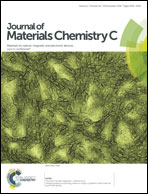Novel phosphorescent polymers containing both ambipolar segments and functionalized IrIII phosphorescent moieties: synthesis, photophysical, redox, and electrophosphorescence investigation†
Abstract
Two series of novel phosphorescent polymers have been successfully synthesized by the Suzuki cross-coupling reaction among functionalized phosphorescent IrIII ppy-type (ppy = 2-phenylpyridine anion) complex monomers with hole-injection/transporting (HI/HT) properties, fluorene-based silane moieties and triphenylamine-oxadiazole hybrid units showing ambipolar features. Their photo-physical, electrochemical, and electroluminescent (EL) properties have been investigated. The concerned results have indicated the efficient energy-transfer from the organic segments to the phosphorescent units in the polymer backbone. The electrochemical characterization has shown that introducing the triphenylamine-oxadiazole hybrid blocks can facilitate the injection processes for both kinds of charge carriers and afford ambipolar features to the copolymers. All these features associated with these novel phosphorescent polymers will guarantee their exceptional EL performances, which have been shown by organic light-emitting devices (OLEDs). The OLEDs based on these phosphorescent polymers can furnish a maximum current efficiency (ηL) of 30.54 cd A−1, an external quantum efficiency (ηext) of 12.93%, and a power efficiency (ηP) of 10.12 lm W−1. So, these attractive results will offer a new outlet to afford functionalized phosphorescent polymers for constructing highly efficient OLEDs with low-cost device fabrication.


 Please wait while we load your content...
Please wait while we load your content...